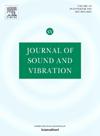具有内隔振系统的水下航行器声辐射数值-解析混合计算方法
IF 4.3
2区 工程技术
Q1 ACOUSTICS
引用次数: 0
摘要
浮筏隔振技术的应用可以有效地降低船舶和水下航行器的机械噪声。掌握准确的设计计算方法是进一步提高浮筏系统减振降噪性能的关键。更高效的建模和求解技术、更广泛的频率范围适用性、更精确的隔振元件仿真是当前浮筏系统设计计算方法研究和实际应用的重点。为了提高具有隔振系统的水下航行器振动声辐射分析的计算效率,提出了一种结合解析和数值技术的多层混合子结构积分方法。水下航行器分为主船体(加劲圆柱壳)和内部多层子结构(基座、隔振器、浮筏等)。采用模态综合超单元法对主船体进行了解析求解,对基础和浮筏进行了建模,得到了动力刚度矩阵。采用四端参数法对隔离器进行建模。然后将这些子结构整合起来计算整体结构的振动和声辐射。对于修改内部隔振系统的场景,只需重新计算局部子结构,并与结构的其余部分耦合,在保持精度的同时提高了效率。该方法解决了纯数值方法的频率限制瓶颈,将频率范围扩展到几千赫兹,在宽带适用性方面取得了重大突破。通过实验测试得到了浮筏隔振器的动刚度矩阵,提高了该方法的工程实用价值。通过数值算例和实验对比验证了该方法的有效性,并讨论了评估过程中的一些潜在模式。本文章由计算机程序翻译,如有差异,请以英文原文为准。
Numerical-analytical hybrid calculation method for acoustic radiation of underwater vehicles with internal vibration isolation system
The application of floating raft isolation technology can effectively reduce mechanical noise in ships and underwater vehicles. Mastering accurate design calculation methods is key to further improving the vibration reduction and noise reduction performance of floating raft systems. More efficient modeling and solving techniques, broader frequency range applicability, and more accurate simulation of isolation components are the current focal points in the research and practical application of design calculation methods for floating raft systems. This paper proposes a hybrid multi-layer substructure integration method, combining analytical and numerical techniques, to improve the computational efficiency of vibration and acoustic radiation analysis in underwater vehicles with vibration isolation systems. The underwater vehicle is divided into a main hull (stiffened cylindrical shell) and internal multi-layer substructures (base, isolators, floating raft, etc.). The main hull is solved analytically, while the base and floating raft are modeled using modal synthesis super-element method to obtain dynamic stiffness matrices. The isolator is modeled using the four-terminal parameter method. These substructures are then integrated to compute the overall structure's vibration and acoustic radiation. For scenarios where the internal vibration isolation system is modified, only the local substructure needs to be recalculated and coupled with the rest of the structure, improving efficiency while maintaining accuracy. This method addresses the frequency limitation bottlenecks of pure numerical methods, extending the frequency range to several kilohertz and enabling significant breakthroughs in broadband applicability. The dynamic stiffness matrices of floating raft isolators, which can be obtained from experimental tests, enhance the method's practical engineering value. The validity of the proposed method is verified through numerical examples and experimental comparisons, and some underlying patterns are discussed during the evaluation process.
求助全文
通过发布文献求助,成功后即可免费获取论文全文。
去求助
来源期刊

Journal of Sound and Vibration
工程技术-工程:机械
CiteScore
9.10
自引率
10.60%
发文量
551
审稿时长
69 days
期刊介绍:
The Journal of Sound and Vibration (JSV) is an independent journal devoted to the prompt publication of original papers, both theoretical and experimental, that provide new information on any aspect of sound or vibration. There is an emphasis on fundamental work that has potential for practical application.
JSV was founded and operates on the premise that the subject of sound and vibration requires a journal that publishes papers of a high technical standard across the various subdisciplines, thus facilitating awareness of techniques and discoveries in one area that may be applicable in others.
 求助内容:
求助内容: 应助结果提醒方式:
应助结果提醒方式:


